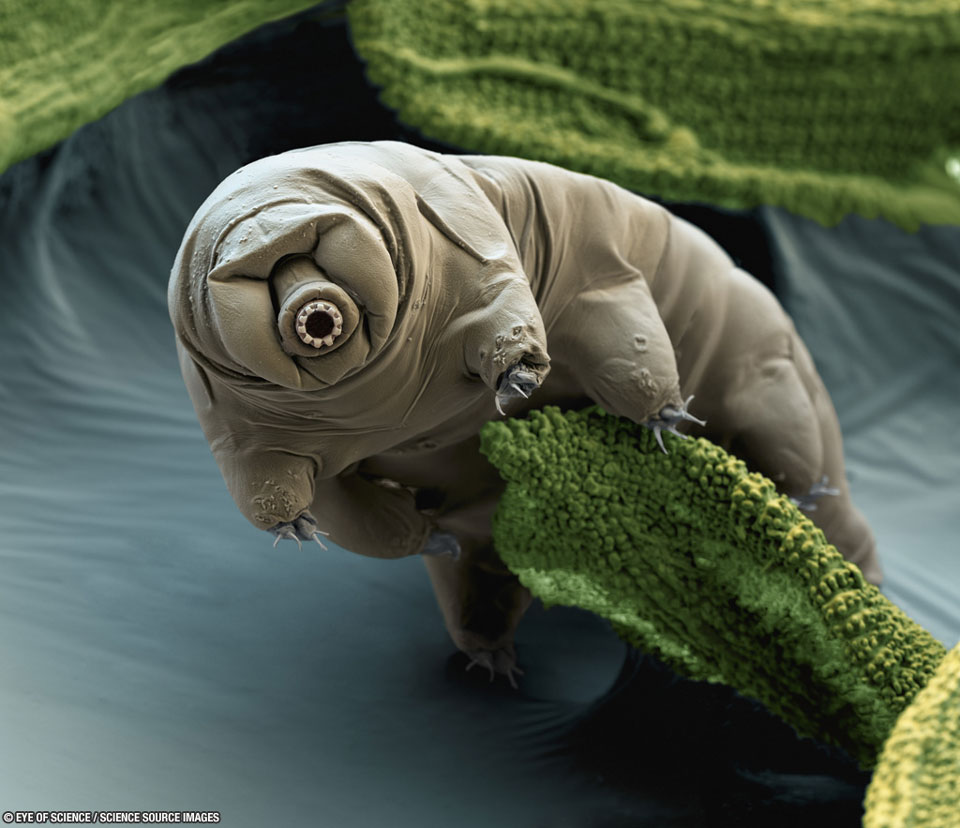21. May 2023
Tī 青苔頂懸 ê 水熊蟲

探索宇宙1!逐工會揀一幅無仝款 ê 影像抑是相片,𤆬你熟似咱這个迷人 ê 宇宙,閣有專業天文學者2為你3解說4。
- 原始文章:Tardigrade in Moss
- 影像來源 kah 版權:Nicole Ottawa & Oliver Meckes / Eye of Science / Science Source Images
- 天頂予你 ê 禮物:你 ê APOD 生日相片是佗一張? (post 1995)
- 台文翻譯:An-Li Tsai (NCU)
[漢羅] Tī 青苔頂懸 ê 水熊蟲
這敢是外星人? 可能毋是,毋過 tī 地球頂懸所有 ê 生物內底,水熊蟲 可能是上倚外星人--ê。 這是因為咱知影講,水熊蟲 就算是無食無啉幾若十冬,嘛猶活會落去。 In tī 溫度 giōng 欲 絕對零度 到 水沸點以上 ê 範圍會當活咧,tī 氣壓 0 以上 到 比 海底 壓力閣較懸 ê 範圍會當活咧,直接 tī 危險 ê 輻射 下底嘛活會落去。 這寡 極端生物 ê 生存適應能力是遮爾強,這捌 tī 2011 年 踅地球 ê 太空船外口 試驗過。 水熊蟲 會遮爾耐操,一部份是因為 in 有法度修復 in 家己 ê DNA,而且 in kā in 身軀內底 ê 水 減到賰幾葩 嘛猶會擋。 有一寡 微型水熊蟲 差一點仔就變做外星生物矣。 Tī 2011 年 ê 時陣,in 按算欲坐火箭到火星 ê 衛星 火衛一 Phobos ,到 2021 年才送轉來到月球。 毋過 2011 年 ê 發射 煞失敗,2021 年 ê 登陸 摔歹去矣。 Tī 地球大部分 ê 所在,水熊蟲 是比 人類 閣較普遍。 這張 加強色彩 ê 電子顯微鏡相片 內底,有一隻 毫米長 ê 水熊蟲 tī 青苔 頂懸咧爬。
[POJ] Tī Chheⁿ-tî téng-koân ê Chúi-hîm-thang
Che kám-sī gōa-chheⁿ-lâng? Khó-lêng m̄-sī, m̄-koh tī Tē-kiû téng-koân só͘-ū ê seng-bu̍t lāi-té, chúi-hîm-thâng khó-lêng sī siōng óa gōa-chheⁿ-lâng--ê. Che sī in-ūi lán chai-iáⁿ kóng, chúi-hîm-thâng to̍h sǹg sī bô chia̍h bô lîm kúi-ā cha̍p tang, mā iáu oa̍h ē lo̍h-khì. In tī un-tō͘ giōng beh choa̍t-tùi-lêng-tō͘ kàu chúi-hut-tiám í-siōng ê hoān-ûi ē-tàng oa̍h leh, tī khì-ap 0 í-siōng kàu pí hái-té ap-le̍k koh khah koân ê hoān-ûi ē-tàng oa̍h leh, ti̍t-chiap tī hûi-hiám ê hok-siā ē-té mā oa̍h ē lo̍h-khì. Chit-kóa ke̍k-toan-seng-bu̍t ê seng-chûn sek-èng lêng-le̍k sī chiah-nī kiông, che bat tī 2011 se̍h Tē-kiû ê thài-khong-chûn gōa-kháu chhì-giām kòe. Chúi-hîm-thang ē chiah-nī nāi-chhau, chi̍t-pō͘-hūn sī in-ūi in ū hoat-tō͘ siu-ho̍k in ka-tī ê DNA, jî-chhiáⁿ in kā in sin-khu lāi-té ê chúi kiám kàu chhun kui pha mā iáu ē-tòng. Ū chi̍t-kóa bî-hêng chúi-hîm-thâng chha chi̍t-tiám-á to̍h piàn-chò gōa-chheⁿ-seng-bu̍t ah. Tī 2011 nî ê sî-chūn, in àn-sǹg beh che hóe-chìⁿ kàu Hóe-chheⁿ ê ūi-chheⁿ Hóe-ūi-it Phobos, kàu 2021 nî chiah sàng tńg-lâi Goe̍h-kiû. M̄-koh 2011 nî ê hoat-siā soah sit-pāi, 2021 nî ê teng-lio̍k siak phái-khì ah. Tī Tē-kiû tōa-pō͘-hūn ê só͘-chāi, chúi-hîm-thâng sī pí jîn-lūi koh khah phó͘-phiàn. Chit-tiuⁿ ka-kiông sek-chhái ê tiān-chú hián-bî-kiàⁿ siòng-phìⁿ lāi-té, ū chi̍t-chiah hô-bí tn̂g ê chúi-hîm-thâng tī chheⁿ-tî téng-koân leh pê.
[KIP] Tī Tshenn-tî tíng-kuân ê Tsuí-hîm-thang
Tse kám-sī guā-tshenn-lâng? Khó-lîng m̄-sī, m̄-koh tī Tē-kiû tíng-kuân sóo-ū ê sing-bu̍t lāi-té, tsuí-hîm-thâng khó-lîng sī siōng uá guā-tshenn-lâng--ê. Tse sī in-uī lán tsai-iánn kóng, tsuí-hîm-thâng to̍h sǹg sī bô tsia̍h bô lîm kuí-ā tsa̍p tang, mā iáu ua̍h ē lo̍h-khì. In tī un-tōo giōng beh tsua̍t-tuì-lîng-tōo kàu tsuí-hut-tiám í-siōng ê huān-uî ē-tàng ua̍h leh, tī khì-ap 0 í-siōng kàu pí hái-té ap-li̍k koh khah kuân ê huān-uî ē-tàng ua̍h leh, ti̍t-tsiap tī huî-hiám ê hok-siā ē-té mā ua̍h ē lo̍h-khì. Tsit-kuá ki̍k-tuan-sing-bu̍t ê sing-tsûn sik-ìng lîng-li̍k sī tsiah-nī kiông, tse bat tī 2011 se̍h Tē-kiû ê thài-khong-tsûn guā-kháu tshì-giām kuè. Tsuí-hîm-thang ē tsiah-nī nāi-tshau, tsi̍t-pōo-hūn sī in-uī in ū huat-tōo siu-ho̍k in ka-tī ê DNA, jî-tshiánn in kā in sin-khu lāi-té ê tsuí kiám kàu tshun kui pha mā iáu ē-tòng. Ū tsi̍t-kuá bî-hîng tsuí-hîm-thâng tsha tsi̍t-tiám-á to̍h piàn-tsò guā-tshenn-sing-bu̍t ah. Tī 2011 nî ê sî-tsūn, in àn-sǹg beh tse hué-tsìnn kàu Hué-tshenn ê uī-tshenn Hué-uī-it Phobos, kàu 2021 nî tsiah sàng tńg-lâi Gue̍h-kiû. M̄-koh 2011 nî ê huat-siā suah sit-pāi, 2021 nî ê ting-lio̍k siak phái-khì ah. Tī Tē-kiû tuā-pōo-hūn ê sóo-tsāi, tsuí-hîm-thâng sī pí jîn-luī koh khah phóo-phiàn. Tsit-tiunn ka-kiông sik-tshái ê tiān-tsú hián-bî-kiànn siòng-phìnn lāi-té, ū tsi̍t-tsiah hô-bí tn̂g ê tsuí-hîm-thâng tī tshenn-tî tíng-kuân leh pê.
[English] Tardigrade in Moss
Is this an alien? Probably not, but of all the animals on Earth, the tardigrade might be the best candidate. That's because tardigrades are known to be able to go for decades without food or water, to survive temperatures from near absolute zero to well above the boiling point of water, to survive pressures from near zero to well above that on ocean floors, and to survive direct exposure to dangerous radiations. The far-ranging survivability of these extremophiles was tested in 2011 outside an orbiting space shuttle. Tardigrades are so durable partly because they can repair their own DNA and reduce their body water content to a few percent. Some of these miniature water-bears almost became extraterrestrials in 2011 when they were launched toward to the Martian moon Phobos, and again in 2021 when they were launched toward Earth's own moon, but the former launch failed, and the latter landing crashed. Tardigrades are more common than humans across most of the Earth. Pictured here in a color-enhanced electron micrograph, a millimeter-long tardigrade crawls on moss.
詞彙學習
| 漢羅 | POJ | KIP | 華語 | English |
|---|---|---|---|---|
| 青苔 | chheⁿ-tî | tshenn-tî | 苔蘚 | moss |
| 水熊蟲 | chúi-hîm-thâng | tsuí-hîm-thâng | 緩步動物門 | tardigrades |
| 外星人 | gōa-chheⁿ-lâng | guā-tshenn-lâng | 外星人 | alien |
| 絕對零度 | choa̍t-tùi-lêng-tō͘ | tsua̍t-tuì-lîng-tōo | 絕對零度 | absolute zero |
| 水沸點 | chúi-hut-tiám | tsuí-hut-tiám | 沸點 | the boiling point of water |
| 輻射 | hok-siā | hok-siā | 輻射 | radiations |
| 氣壓 | khì-ap | khì-ap | 氣壓 | atmospheric pressure |
| 極端生物 | ke̍k-toan-seng-bu̍t | ki̍k-tuan-sing-bu̍t | 極端生物 | extremophiles |
| 外星生物 | gōa-chheⁿ-seng-bu̍t | guā-tshenn-sing-bu̍t | 外星生物 | extraterrestrials |
| 發射 | hoat-siā | huat-siā | 發射 | launch |
| 登陸 | teng-lio̍k | ting-lio̍k | 登陸 | landing |
| 火衛一 Phobos | Hóe-ūi-it Phobos | Hué-uī-it Phobos | 火衛一福波斯 | Phobos |
| 微型水熊蟲 | bî-hêng chúi-hîm-thâng | bî-hîng tsuí-hîm-thâng | 微型水熊蟲 | miniature water-bears |
| 火星 | Hóe-chheⁿ | Hué-tshenn | 火星 | Mars |
| 電子顯微鏡相片 | tiān-chú hián-bî-kiàⁿ siòng-phìⁿ | tiān-tsú hián-bî-kiànn siòng-phìnn | 電子顯微鏡相片 | electron micrograph |
| 毫米 | hô-bí | hô-bí | 毫米 | millimeter |